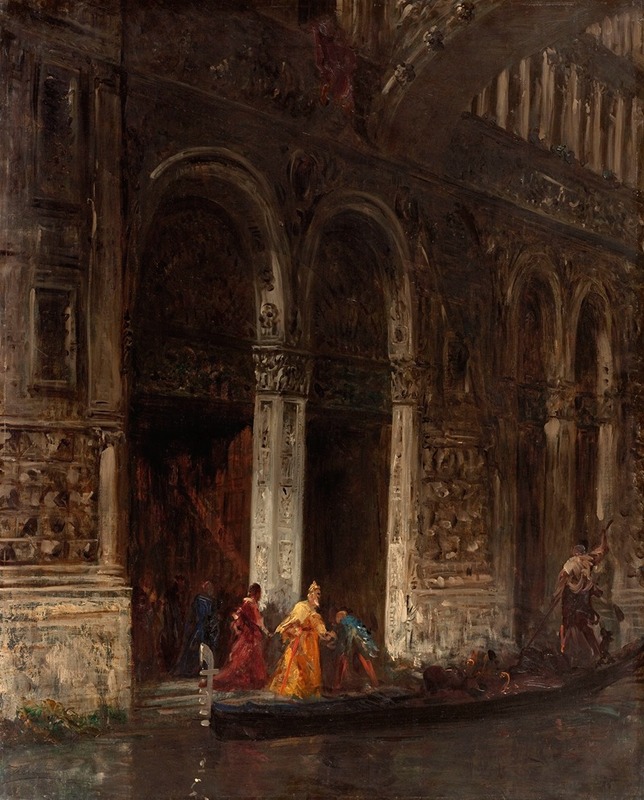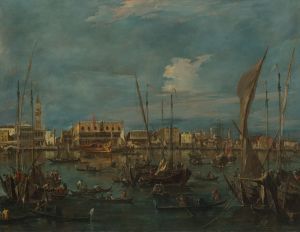
La sortie du Palais des Doges sous le pont des Soupirs
A hand-painted replica of Félix Ziem’s masterpiece La sortie du Palais des Doges sous le pont des Soupirs, meticulously crafted by professional artists to capture the true essence of the original. Each piece is created with museum-quality canvas and rare mineral pigments, carefully painted by experienced artists with delicate brushstrokes and rich, layered colors to perfectly recreate the texture of the original artwork. Unlike machine-printed reproductions, this hand-painted version brings the painting to life, infused with the artist’s emotions and skill in every stroke. Whether for personal collection or home decoration, it instantly elevates the artistic atmosphere of any space.
Félix Ziem was a 19th-century French painter known for his vibrant and atmospheric landscapes, particularly those depicting Venice and the Mediterranean. One of his notable works is "La sortie du Palais des Doges sous le pont des Soupirs," which translates to "The Exit of the Doge's Palace under the Bridge of Sighs." This painting captures a quintessential Venetian scene, highlighting Ziem's fascination with the city's unique architecture and waterways.
Ziem was born on February 26, 1821, in Beaune, France. He initially trained as an architect before turning to painting, a decision that would lead him to become one of the most celebrated Orientalist and landscape painters of his time. His travels to Italy, particularly Venice, greatly influenced his work. Venice, with its intricate network of canals and historic buildings, provided Ziem with endless inspiration, and he became renowned for his ability to capture the city's light and atmosphere.
"La sortie du Palais des Doges sous le pont des Soupirs" is a fine example of Ziem's Venetian works. The painting depicts the iconic Bridge of Sighs, a covered bridge made of white limestone that connects the Doge's Palace to the New Prison in Venice. The bridge is one of the most famous landmarks in Venice, known for its distinctive design and historical significance. It was built in 1600 and has since become a symbol of the city.
In Ziem's painting, the viewer is presented with a scene that combines architectural grandeur with the lively activity of the Venetian canals. The Doge's Palace, a masterpiece of Gothic architecture, serves as a backdrop, while gondolas glide through the water beneath the Bridge of Sighs. Ziem's use of color and light is particularly noteworthy; he employs a warm palette that captures the shimmering reflections on the water and the soft glow of the Venetian sky.
Ziem's technique often involved loose brushwork and a focus on capturing the transient effects of light and atmosphere, characteristics that align him with the Impressionist movement, although he is not formally categorized as an Impressionist. His ability to convey the essence of a place through his paintings made him a popular and influential artist during his lifetime.
The painting not only reflects Ziem's technical skill but also his deep appreciation for Venice's beauty and history. His works, including "La sortie du Palais des Doges sous le pont des Soupirs," are celebrated for their ability to transport viewers to the enchanting world of 19th-century Venice.
Félix Ziem's contributions to art were recognized during his lifetime, and he enjoyed considerable success. He was awarded the Légion d'Honneur in 1857, a testament to his impact on the art world. Today, his works are held in high regard and can be found in major museums and private collections around the world.
In summary, "La sortie du Palais des Doges sous le pont des Soupirs" is a testament to Félix Ziem's mastery of landscape painting and his enduring fascination with the city of Venice. Through his skilled use of color, light, and composition, Ziem captures the timeless allure of one of the world's most iconic cities, offering viewers a glimpse into its rich architectural and cultural heritage.


















